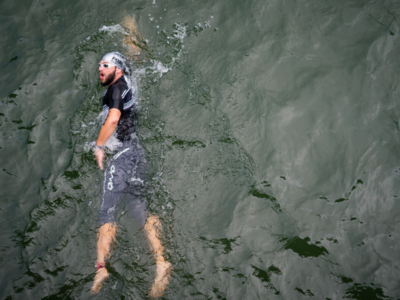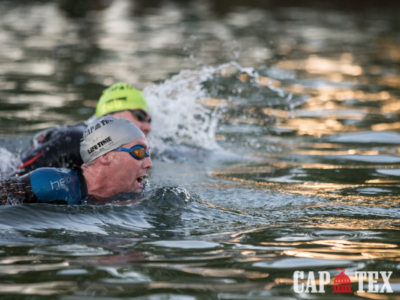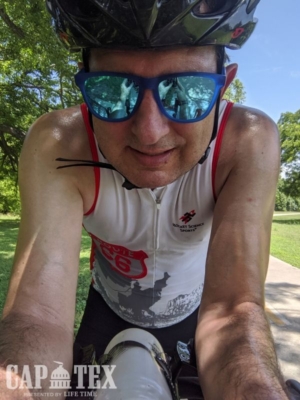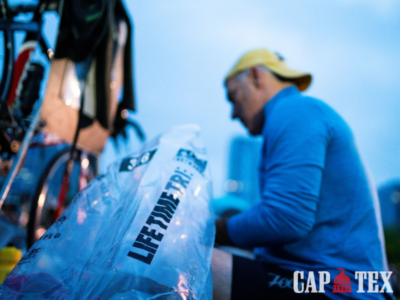Posts
When to Wear a Wetsuit
Sometimes because of colder water temperatures, a tri suit is not enough and triathletes will opt to add a wetsuit to wear during the swim. Wearing a wetsuit has many advantages and a few disadvantages, so what are they? When are they helpful or even required? Should I go for a two-piece or one-piece? We created this wetsuit guide to help you make the right decision for your event.
Remember the golden rule: Nothing new on race day. Unless you have an opportunity to swim in the exact wetsuit you will wear on race day at least once before, it is advised to not try something new the day of the race.
Types of wetsuits
A wetsuit is a neoprene insulation suit made for warmth during the swim portion of a triathlon. Triathlon wetsuits are different from other water sports wetsuits and are regulated by governing bodies like USAT. Wetsuits for a triathlon cannot be more the 5mm thick.
The two most common types are sleeved and sleeveless. Full-sleeved wetsuits are better for the coldest water temperatures and are the most efficient. Sleeveless is great for cooler water temperatures but lets in water which can cause drag. Short “jammer” styles have gained in popularity for short-distance triathlons since they are the easiest to put on and take off.
In terms of cost, sleeveless is usually less expensive. Less expensive wetsuits will also typically have uniform neoprene while the materials in high-end suits will vary across the body and incorporate more technology into the fabric.
Remember, you want the fit to be snug, but not restrict breathing or inhibit arm movement.
Why Wear a Wetsuit?
“Free” Speed
Wearing a wetsuit is one of the easiest ways to get faster swim times. The suit allows the wearer to swim faster and reduces the effort the swimmer has to put in. The better the swimmer the less advantage the wetsuit may show. A swimmer can expect to save anywhere from a few seconds to tens of seconds per 100 meters. Usually, the longer the distance the more the savings are noticeable. With less exertion in the water, you will feel less of an energy drain as you are heading up to T1.
Warmth
The wetsuit can provide warmth to the swimmer in the cold water. If you are sensitive to the cold the coverage can be great at making you more comfortable in the water. Wetsuits are highly advised for water temps between 50 to 65 degrees.
Why Not Wear a Wetsuit?
Cost
Wetsuits can be a big investment costing anywhere from just over $100 to almost $1000. You can check with local stores to see if they rent suits or try and find second-hand wetsuits through Facebook groups. It is also important that you take proper care of the wetsuit as the neoprene can degrade over time.
Constricting
Wetsuits should fit snugly without restricting breathing. That said, some people still find them to cause a claustrophobic feeling especially once they start warming up from swimming. Practicing is important so you can see how your body reacts. If you panic or feel uncomfortable in a full sleeve, you might try a sleeveless wetsuit or wetsuit jammers.
Added Time For Taking Off
While they may save you time while swimming, you still have to get out of the wetsuit. This can add minutes to your transition time.
So, to sum it up, for a short swim of a super sprint or sprint triathlon, the time savings of wearing a wetsuit can be negligible. It is really a toss-up to how you feel on race morning and what you have trained for. Pack it in your bag and if it comes time to leave transition and you don’t want to wear it, simply leave it by your bike. For longer distances like an Olympic or Half Distance, a wetsuit will have clear time-saving benefits that outweigh the extra time of removing the suit.

USAT’s Rule on Wetsuits and Water Temperatures
All temps refer to surface water temperatures
Under 50 degrees: Not suitable for open water swimming, even with a wetsuit
50 to 65 degrees: Suitable for open water swim, but a wetsuit is highly advised
65 – 78 degrees: Suitable for swimming with or without a wetsuit. Sleeveless suits are popular at this temp.
78 – 84 degrees: Race directors use their judgment to allow or not allow wetsuits at this range. Usually not eligible for awards at this temperature.
Over 84 degrees: Wetsuits not allowed
How Can I Speed Up My Triathlon Transitions?
A triathlon is a competition with three sports, which means there are two points in the race where you must transition from one sport to the next. It can take a lot of practice to get good at transitioning between the sports, but there are things you can do to make it faster!
We made a list of some simple strategies can that can help you speed up your triathlon transitions.
Visualize a Plan & Practice on it
Triathletes should be ready with a plan and train themselves accordingly beforehand. You should practice rigorously and leave no room for error. Learning to execute the plan perfectly will enable you to have quick transitions.
Getting the Wetsuit Off Faster
Applying a lubricant to your body before putting on the wetsuit will enable you to slide out of it easily during the first transition. Locating the zip cord quickly and kicking off the suit as soon as possible saves a lot of time.
Only the Essentials
Take things that are absolutely essential. Skipping unnecessary items reduces the number of tasks to be done and saves time.
Be Quick With the Helmet
Your helmet should be kept unfastened prior to the race. Make proper adjustments so that it fits your head and can be removed comfortably. Train yourself to secure the helmet on your head as quickly as possible.
Use This Bike Shoe Trick
Fastening your shoes to the pedals of your bike expedites the process of transition. Thin rubber bands can be used for this purpose. Keep the shoes fully loosened so that you can sit on the bike and put them on swiftly.
Running With the Bike
In the transition zone between swimming and cycling, you are not allowed to ride your bike. Practice running safely and smoothly while holding your bike. By clearing this distance quickly you can deduct some seconds from your overall timing.
Putting on the Running Shoes
You can sprinkle some talcum powder on your running shoes to facilitate a smooth entry of your feet into the shoes. Swap your ordinary shoelaces with speed laces or lace locks.
Maintain Balance
Some of these strategies like wearing shoes while sitting on the bike may seem a little difficult to achieve. But proper training can help you achieve the perfect balance. Along with quick execution, steadiness is also important. Do not move too fast, maintain proper balance.
Study the Racetrack Properly
Have the map of the racetrack in your mind. Repeatedly play the whole scenario in your imagination and prepare yourself to take the right step at the right time.
Training your body and mind for faster triathlon transitions gives you an edge over others, which is why triathletes should incorporate transition practice and the suggestions above into their tri training sessions.
Incorporate Mindfulness Into Your Training
Whether you’re training to be faster or are simply exercising to relax and destress, practicing mindfulness during your physical activities in order to better connect with your body is a great way to achieve a balanced state of mind and find joy in your training.
Often when we hear the word ‘mindfulness’ or ‘meditation’, we envision someone sitting on a yoga mat by the beach, practicing slow and thoughtful movements. But a mindful state can and should be achieved through any activity, especially in triathlon training.
What Do We Mean When We Say Mindfulness?
The simplest definition is the practice of being aware and present at the moment. When it comes to training it means we are being mentally connected to our bodies and train our minds and bodies together as one unit. When we only focus on our physical self without also training the mind, we can create a disconnect between the two, causing negative thoughts and a higher perceived exertion during an event.
Why is Mindfulness Important?
Mindfulness has been shown to help improve focus, decrease stress levels, and increase self-awareness. If you’re looking for a way to improve your performance, incorporating mindfulness into your training is definitely something you should consider. With mindfulness, you can learn how to be more patient, focused, and relaxed during physical activity- leading to better results overall.
How to Incorporate Mindfulness
1) Slow Down
Endurance activities are actually very conducive to achieving a meditative state of mind, and it starts with slowing down and focusing on your form. It’s important to be precise during swimming strokes and land lightly when running so that you can move more efficiently–don’t get frustrated if thoughts wander off while doing this! When we catch ourselves thinking about something else, just relax and refocus back onto the specific element of our movement.
2) Remember Your Goals
Also helpful while practicing mindfulness during workouts, is to have a goal for your workout and keep it top of mind. Maybe today’s goal is to add an extra mile on your run, or maybe it’s to focus on getting your core stronger. Whatever your reason may be for doing your workout, keep it locked in the forefront of your mind to help remind yourself why you’re doing the activity you’re doing.
3) Practice Belly Breathing
Another helpful tip is one we can learn from babies, which is the act of belly breathing. Inhale slowly, extending the belly outward. This helps draw the breath into the lower lungs and extend the diaphragm. By fully inflating the lungs, you’re also taking in the maximum amount of oxygen possible with each breath. These deeper inhalations keep the body relaxed and help you pace yourself and move most efficiently.
Mindfulness can be an important tool in your training arsenal, especially if you struggle with stress or focus. By practicing being aware and present, you can improve your connection to your body and train both the body and mind as one unit. When it comes to competition or a challenging workout, this can be the difference between success and failure. Give mindfulness a try and see how it impacts your performance!
What It’s Like to Complete a Virtual Triathlon
Everything You Need To Know About Completing a Virtual Triathlon
CapTex Tri went virtual this year, and while we know that’s not ideal, that sure didn’t stop these two from accomplishing their tri goals! The best part about a virtual triathlon: you complete it at your pace, on your time. These die-hard triathletes were determined to complete the Virtual CapTex Triathlon or Duathlon anyways, and did just that! While their approach was different, Joey did the whole thing in one day and John did it pieced together, it’s fine to do a virtual triathlon/duathlon either way. Keep reading to see how much they enjoyed their Virtual CapTex Tri experience, and hopefully you’ll be inspired to join in on Virtual races when you can!
Joey Trimyer’s Virtual CapTex Tri Journey
I wasn’t planning on doing the CapTex virtual race because my hip has been bothering me for a while. On Thursday, I saw my doctor he ordered x-rays and prescribed a round of steroids for the inflammation. I hadn’t had the x-rays yet and the steroids hadn’t had time to take effect, but when I got an email promising homemade pickles if I took the challenge and wrote a report I was in.
Sunday afternoon I loaded my gear and drove over to Govalle Park. I like doing multisport workouts here because there are several flat running routes to choose from and you are right at the head of the Walnut Creek trail.
Joey’s Game Plan
My plan was to do the sprint du: 2 mile run, 13.3 mile bike and a 3.1 mile run.
The first run was uneventful. It was super humid and I did not enjoy running in air you could eat with a fork, but then I had waited until the afternoon so I got what I deserved. There was a decent amount of walking and my hip definitely started complaining, but I got it done and got my bike ready to ride.
12.3 miles on the bike went by fairly easily. I just rode along and didn’t worry about pace. The Walnut Creek Trail is a nice out and back and I got to turn around right before the big hill which is always a good thing. One drawback to delaying until the afternoon is that you tend to encounter more cyclists and hikers clogging the path, but overall, the congestion was minimal.
The final 5k involved more jogging and walking than I would have liked, but again I got it done. Virtual events hadn’t ever really appealed to me, but given the circumstances, it was nice to have a little motivation to get out and be active.
John Chung’s Virtual CapTex Tri
I decided to change things up a bit for CapTex Tri virtual, instead of scheduling a dedicated workout for each of the disciplines of the virtual tri and go as hard as I can, I would incorporate them into my normal weekly workouts. The time would be slower but it would be interesting to see by how much of a difference.
John’s Strategy
First Run
I chose the sprint duathlon option, a distance that would easily be incorporated into my weekly workout schedule. For the first 2 mile run, I timed it during my Tuesday morning run. The workout was a Fartlek workout. After the warmup, we went straight into the interval. We start with the effort level around half marathon, gradually increasing it as the interval becomes shorter. Time for the 2 miles was 16:25. 
Bike Ride
The bike portion was timed during a ride out to see my co-worker son’s graduation parade. The ride was through town on neighborhood streets, with red lights and stop signs. I was amazed at how much time I spent waiting and not moving. My “moving” time for the 12.3 miles was a bit over 47 minutes, total time on the bike was more than 1 hour. I spent roughly 15mins or ⅓ of the time sitting at lights or stop signs not moving.
Final Run
For the final 3.1 mile run, the time was from my weekly longish run. The run was an out and back at 9ish total miles. Since I don’t own a GPS watch, I mapped out online the section of the run to figure out the start and stop of the 3.1 miles. Time was measured for both the out and the back, and it was within minutes of each other. I was pleased with the effort considering the out was downhill and the back was uphill. The 3.1-mile time was a bit over 24 minutes.
It was fun to mix in some higher effort intervals into my routine workout to mix it up a bit and keep it interesting.
Go Virtual, Join the Fun!
As you can see, these guys made the most of their time during their virtual tri. After all, it’s a fun way to switch up your fitness routine. Also, a fun challenge if you’re for a new way to get out and be active. Since a virtual tri is completed on your own time, at your own pace, the level of intensity is all up to you. If you participated in the Virtual CapTex Tri this year, tell us about it! We’re on Instagram, Facebook, and Twitter or tag us at #CapTexTriVirtual. We would love to hear about your experience!
Swim Faster with Fins
Use fins during your swim training to become faster in the water
Do you want to improve your kick strength, ankle flexibility, body position, and increase your speed in the water? If you’re thinking, duh, try adding fins to some of your swimming workouts for your upcoming tri! With the right amount of training and the right tools, you’ll be on track to improve your swimming abilities for CapTex Tri in no time.
Why you should use fins
Wearing swim fins increases the amount of resistance your muscles experience as you kick, guaranteeing you’ll put your leg muscles to full use. Stronger legs and the additional strength will carry over into normal swimming when you’re not wearing your fins.
Another benefit of using fins is improved ankle flexibility. This stems from the extra force the fins place on your ankles as you kick. Increased ankle flexibility will result in a more efficient flutter kick through better angles of attack in the water. When you are unable to fully flex your ankles into a streamlined position the ankles remain somewhat bent, catching water instead of propelling the body through it.
Do you have some other new swim equipment? This Rookie Tri blog shows you how to incorporate other swim equipment into your triathlon training.
Technique-focused workout
You’ll want to focus on a slow-motion, over-exaggerated flutter kick. During this workout, focus on slowing down the kick cycle and dramatically increase your range of motion. The over-exaggerated technique allows swimmers to more easily tune into ankle flexion and proper body alignment throughout the kick. As a bonus, this drill is also quite taxing on the legs and core – the increased workload of a large kick also makes for a great strength-building exercise.
2 Rounds
 2 x 25 over-exaggerated flutter kick (with kickboard)
2 x 25 over-exaggerated flutter kick (with kickboard)
4 x 25 freestyle, easy
2 x 25 over-exaggerated flutter kick (no kickboard)
4 x 25 freestyle, mid-level effort
2 x 25 over-exaggerated flutter kick (with kickboard)
4 x 25 freestyle, easy
Essential Race Day Skills You Need to Know for Your Upcoming Tri
Leave no room for surprises during your upcoming tri with these essential race day skills you need to know
Despite all the planning and prepping to make the morning of your tri go perfectly, we all know that some things are out of our control. Expected the unexpected and prepare yourself by mastering these essential race day skills to handle whatever comes your way on race day.
How to Fix a Dropped Chain
Get off the bike and steady it in an upright position against something sturdy. To add slack to the chain, push the rear derailleur toward the pedal (forward or inward), and then use your other hand to free the chain from the chainrings or pedals. Line the chain back up with a chainring and cassette to put the chain back in place. Lastly, lift the rear of your bike a few inches of the ground and give the pedals a few turns to allow the chain to find its gear. This seems insignificant, but it’s an important step to keep your chain from more wear and tear throughout the rest of your ride.
How to Ride in the Rain
Check the weather on race morning to see if you should be prepared to ride in the rain. Throughout the course, avoid standing water. You never know what could be underneath a puddle, and you don’t want to risk a flat tire in wet conditions. Also, be on the lookout for rainbow-colored oil patches to avoid slipping. Stay within your comfort zone, and take your time and be cautious around corners to prevent losing control. Last but not least, bring some protection for your eyes! Hopefully, you do this when out for any ride, but you will be glad you did in the case of riding in the rain.
How to Ride While Taking a Drink
You’re bound to get thirsty during the bike portion, so be prepared to ride with one hand during a race. Practice makes perfect. During your training, practice this race day skill by removing one hand at a time to build up your confidence. Start with shorter distances, and before you know it you’ll be pro at riding with one hand. This will allow you to eat, drink and signal to other riders while making your way to the finish line.
How to Sight in the Water
 To avoid swimming a further distance during your tri, sighting is an essential race day skill you should practice before an open-water swim. You need to look where you’re going every few strokes to make sure you are staying within the buoys. The best method of sighting is to incorporate glancing forward before you go to take a breath. It is recommended to sight every 2 – 3 strokes, but in order to find what works best for you, you will just have to practice. Pro tip: Look at the swim course before-hand to see if the course goes clockwise or counter-clockwise, then you’ll know to stay on the right or left side of the buoys.
To avoid swimming a further distance during your tri, sighting is an essential race day skill you should practice before an open-water swim. You need to look where you’re going every few strokes to make sure you are staying within the buoys. The best method of sighting is to incorporate glancing forward before you go to take a breath. It is recommended to sight every 2 – 3 strokes, but in order to find what works best for you, you will just have to practice. Pro tip: Look at the swim course before-hand to see if the course goes clockwise or counter-clockwise, then you’ll know to stay on the right or left side of the buoys.
How to Look Over Your Shoulder on the Bike
Once you perfect riding with one hand, you’ll be ready to look over your shoulder during your ride. It’s important to be aware of your surroundings during a ride to keep yourself, and others around you safe. It’s all about shifting your weight correctly and keeping your knees, pelvis, and front-wheel facing forward. We advise performing this drill in a parking lot, or on an empty street to make sure you can still ride straight while turned around.
How to Change a Flat
Follow these 10 simple steps to fix a flat, and you’ll be back in the race in no time.
1. Pull over and find a safe place off the road to change tire
2. Remove the wheel from the bike.
3. Remove the tire with levers from the wheel
4. Check your tire for large punctures or sharp items
5. Check the rim of the wheel for anything that might have punctured through the rim tape
6. Pop one side of the tire back over the rim of the wheel
7. Put the new tube back inside tire
8. Push the free tire wall back onto the rim
9. Inflate the new tube.
10. Put the wheel back on the bike.
Once you’ve conquered these essential race day skills you need to know for your upcoming tri, there will be nothing in your way as you head for the finish line!


